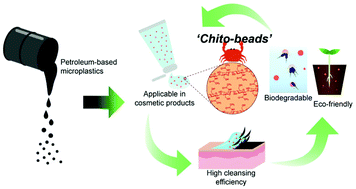Biodegradable chito-beads replacing non-biodegradable microplastics for cosmetics†
Abstract
The global ban on plastic microbeads for personal care products has forced researchers to find sustainable alternatives. However, current biodegradable microbeads rarely offer competitive qualities such as those related to the mechanical properties, stability, and toxicity of their degraded products. Herein, we synthesized ‘chito-beads’, which can satisfy the aforementioned requirements, and evaluated their practical usage, biodegradability, and phytotoxicity. Chito-beads were made into uniform spherical microbeads with a diameter of 280 μm through the reacetylation of chitosan – a renewable polymer from crustacean waste via an inverse emulsion system. Chito-beads exhibit a higher cleansing efficiency than conventional polyethylene microbeads, with a hardness of 128 MPa. Furthermore, they can be used to remove potentially toxic elements and are stable and functional in commercial cleansing. The used chito-beads were fully degraded in soils without any toxicity to the model plants. Our alternative can be used as competitive and environmentally friendly microparticles in sustainable daily necessities.



 Please wait while we load your content...
Please wait while we load your content...